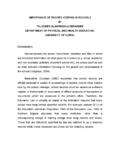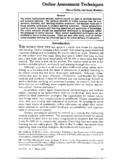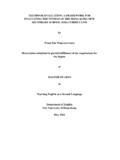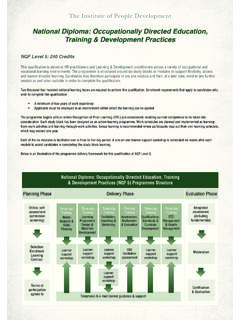Transcription of THE USE AND PRINCIPLES OF CONTINUOUS …
1 THE USE AND PRINCIPLES OF CONTINUOUS assessment . IN THE CLASSROOM. BY. SHEHU RAHEEM ADARAMAJA DEPARTMENT OF PHYSICAL AND HEALTH. EDUCATION, FACULTY OF EDUCATION, UNIVERSITY OF ILORIN. Introduction Educational assessment provides the necessary feedback required in order to maximize the outcomes of educational efforts. The assessment of learners' learning provides objective evidence necessary in the decision- making process in education. As correctly pointed out by Cone and Foster (1991), good measurement resulting in accurate data is the foundation of sound decision making. In 2004 near the end of the academic year, which is a time for revision and preparation for the end of the year examination, while I was revising with the learners and informing them on the number of papers and questions they would be writing, a pupil asked Sir, why are we taught for a whole year and then given a two hour paper to determine whether or not we know the subject?
2 Another asked, would a one shot examination adequately assess what we had learnt over a long period of schooling? How would you grade learner who happens to fall ill and could not write the final examination? In attempt to answer those questions and many more, educational measurement experts and policy makers have come up with the concept of CONTINUOUS assessment . What is CONTINUOUS assessment ? CONTINUOUS assessment is the periodic and systematic method of assessing and evaluating a person's attributes. Information collected from CONTINUOUS behaviour of students will help teachers to better understand their strengths and weaknesses in addition to providing a comprehensive picture of each student over a period of time. Such information will help in educational and vocational placement of students.
3 CONTINUOUS assessment will afford student to readily see his or her developmental pattern through the data. CONTINUOUS assessment of learners' progress could also be defined as a mechanism whereby the final grading of learners in the cognitive;. affective and psychomotor domains of learning systematically takes account of all their performances during a given period of schooling (Faleyalo, 1986). assessment in the cognitive domain is associated with the process of knowledge and understanding. The effective domain applies to characteristics such as attitudes, motives, interests and other personality traits. assessment in the psychomotor domain involves assessing the learners' ability to use his or her hands ( in handwriting, construction and projects). From these definitions, one could infer that CONTINUOUS assessment is an assessment approach which involves the use of a variety of assessment instruments, assessing various components of learning, not only the thinking processes but including behaviors, personality traits and dexterity.
4 CONTINUOUS assessment will also take place over a long period of time. Such an approach would be more holistic, representing the learner in his/her entirety. It will begin with the decisions that the teachers perform on the first day of school and end with the decisions that the teachers and administrations make on the learners regarding end-of-year grading and promotion. CONTINUOUS assessment will however, not be successful without the dutiful commitment, diligence and sacrifice on the part of teachers. The task is difficult and calls for dedicated objectivity and handwork on the part of the teachers, counselors and everybody involved in the education of the child. Origin of CONTINUOUS assessment The present National Policy on Education observed that the existing practice (in most institutions of learning) of basing the assessment of students' work on final examination and on one type only as no longer tenable.
5 The policy further points out that the first school leaving certificate examination will ultimately be abolished and primary school learning certificate will be issued by the headmaster of individual schools and will be based on CONTINUOUS overall guidance-oriented assessment of pupils and not on the results of a single final examination. Such assessment will be done by teachers and the headmasters. The introduction of CONTINUOUS assessment in the National Policy of Education dated back to 1969 curriculum development conference in a paper presented by National Education Research Council (NERC). The National Policy on Education (1981:8) stated that: Ultimately, there will be no formal examination at the end of the first six years of primary education, certificate will be based on CONTINUOUS assessment .
6 At the end of the first three years following primary education, the junior secondary school certificates will be based on final examination and CONTINUOUS assessment method. The certificate will be issued by the head of the institution- . At the end of the second three years course (Senior Secondary) a formal examination will be given but the performance during the three years will be weighted and taken into account for certificate purpose. The university and other institutions of higher learning will also be required to explore ways of introducing an element of CONTINUOUS evaluation/ assessment of their students.. The National Policy of Education is advocating for the following in all institutions of learning with particular reference to 6-3-3- 4 OR 9-3- 4. system of education.
7 1) Primary education = 2) Junior Secondary Education = CA +Final Examination 3) Senior Secondary Education = CA + Final Examination 4) Higher Education = + Final Examination The CONTINUOUS assessment in all constitutes 40% or 30% of the total marks (depending on educational level) except for primary education where constitutes a total of hundred marks In some schools this 31%. or 40% is divided into three grade assessment , others prefer two graded tests. Attendance, at time constitutes part of this grading in some schools. Teachers are the alpha and omega ( have the final say when it comes to the mark or score of the students) of their subjects. Characteristics of CONTINUOUS assessment The following are the characteristics of CONTINUOUS assessment . (a) Systematic (b) Comprehensive (C) Cumulative (d) Guidance -Oriented (a) Systematic Nature of CONTINUOUS assessment : CONTINUOUS assessment is said to be systematic in the sense that it requires an operational plan which indicates what measurement are to be made of the pupils' performance, at what time intervals or times during the school year, the measurements are to be made and the results recorded, and the nature of the tools or instruments to be used in the measurements.
8 (b) Comprehensive Nature of CONTINUOUS assessment : CONTINUOUS assessment is comprehensive in the sense that many types of instruments are used in determining the performance. CONTINUOUS assessment may come in form of tests, projects, assignments, observations, questionnaire and interviews. (c) Cumulative Nature of CONTINUOUS assessment : is cumulative since any decision to be made at any point in time on the pupil takes into account of all previous decisions about him. This requires the keeping of up-to-date or cumulative records of each pupils. (d) Guidance-Oriented Nature of CONTINUOUS assessment : is guidance-oriented because information is used to guide his placement, career prospects, vocational training and further development. Some of the Forms that CONTINUOUS assessment Can Take CONTINUOUS assessment can be organized and implemented in a large number of different ways, and the actual assessment procedures can take many different forms.
9 This include: (a) Tests (i) Essay test (ii) Objective tests (b) Project/Assignment Techniques (c) Observation Techniques (d) Sociometric Techniques (f) Interviews (g) Class attendance etc (h) Rating scale (i) Check list (j) Inventory etc. How to Plan and Organize CONTINUOUS assessment Because of the wide variety of forms that CONTINUOUS assessment can take, it is difficult to provide detailed guidelines on how to plan and organize such assessment . We can however, provide a number of general guidelines on how to do so, and it is hoped that readers find these helpful. The guidelines are again framed around those given by Bob Purvis in his CICED booklet on CONTINUOUS assessment '. 1. Ensure that the proposed assessment scheme, is progressive and properly integrated, and that the different assessment vehicles are appropriately matched to the objectives, learning outcomes of competence that they are intended to asses (student performance should prove useful here).
10 2. Remember that examinations and other terminal assessment ' vehicle can be used together with CONTINUOUS assessment programmes, so try to use both modes of assessment in the most effective and complementary way. 3. Always tell your students exactly what you expect them to do, and make sure that your requirements and ground rules' are properly adhered to. Ensure that other members of staff involved in teaching the courses are also fully informed of your plans; their comments will generally be useful. 4. Ensure that any written instructions or guidelines provided to your students are clear, unambiguous and helpful. 5. Make sure that you create appropriate opportunities for students to discuss the CONTINUOUS assessment programme with yourself and any other members of staff involved, both before they embark on the programme and during the programme itself.









